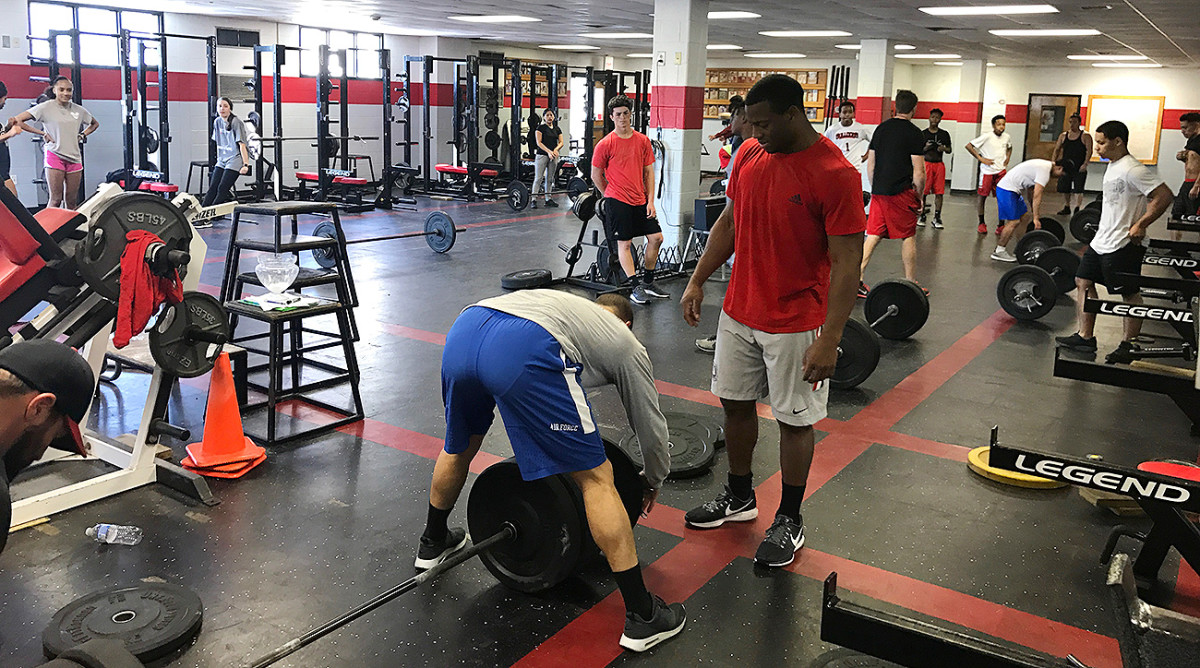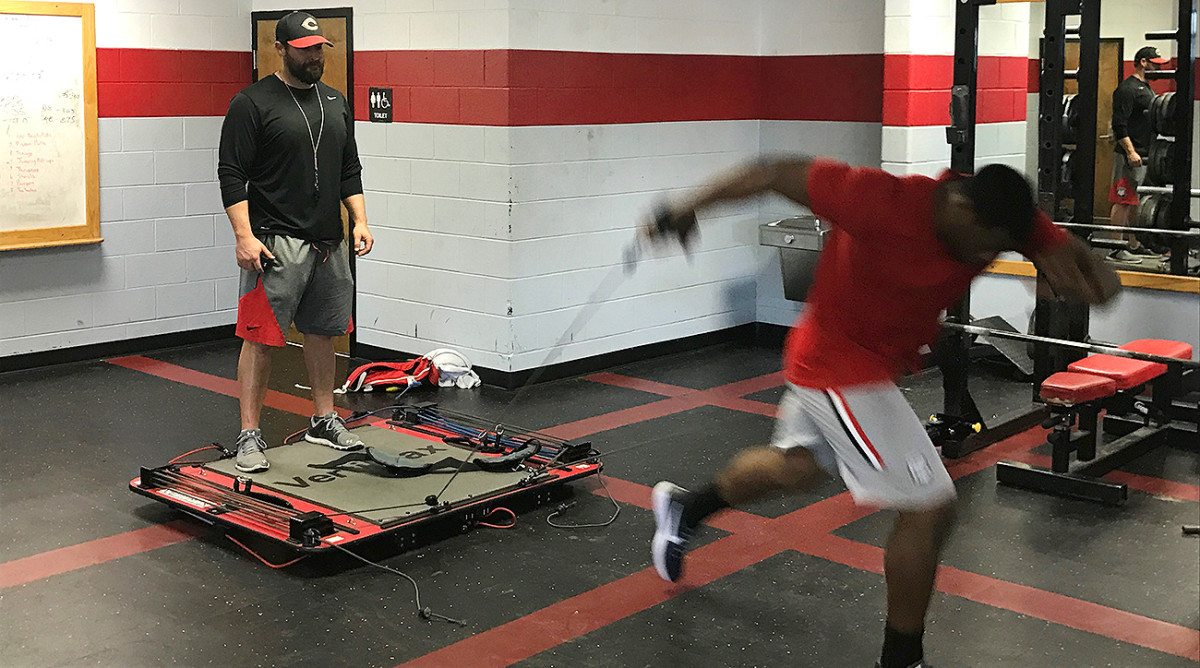Nick Chubb Keeping Things Familiar During His NFL Combine Prep

CEDARTOWN, Ga. — Last Thursday Nick Chubb was wrapping up his second workout of the day. Typically he’d have a third, but with the NFL combine approaching, his prep training was winding down.
Nearly 30 minutes into the workout, he completed six sets of two 315-pound squats—with resistance bands tied to the bar—with ease. Then he cleaned 335 pounds eight times without a hint of sweat on his brow.
Chubb, the former Georgia running back considered by many to be a top-50 prospect in April’s NFL draft, took the 45-pound plates off the bar, ready to return them to their place in the weight room. But first he had to wait on 18 high schoolers to finish their high-stretches on the other side of the room.
Rather than training in South Florida or going to a glitzy performance facility such as EXOS or IMG, as has become the tradition among each class of draft prospects, Chubb opted for familiarity for his NFL combine prep, and that means working out in his town of fewer than 10,000 people at the Cedartown High School gym that he has to share with weight-lifting classes.
“It was definitely a big business decision for me because I know these other places have nicer things and better equipment that would better aid me,” Chubb says. “But I looked around and I had to go with what I know, and this is where I wanted to be.”

This is the place that prepared Chubb for all his success so far. This is where he rushed for nearly 7,000 rushing yards in high school, and where he won his Georgia shot-put state title. This is where he power-cleaned 405 pounds as a senior and where he trained leading up to his SEC Freshman of the Year season with 1,547 rushing yards for the Bulldogs.
Mike Worthington, the head track coach and assistant football coach of Cedartown High School, has known Chubb since eighth grade and has been working with him since his freshman year of high school—and Worthington has invested himself into making Chubb has strong as possible. Chubb never took a spring break trip at Georgia, instead opting to go back home and work out with Worthington. In the summer, the running back would text his old coach for workout plans to run with the Bulldogs walk-ons.
“I’ve got some players I’m close to now,” Worthington, 41, says, “but I doubt I’ll have another kid that I coached that I put as much time into and have this strong of a relationship with.”
Long-time agent Pat Dye Jr. met with Chubb early in his senior season and, as part of the routine checklist, asked the back where he would consider training for the draft. When Chubb mentioned Cedartown, Dye figured things might change when Chubb heard pitches from different agents or saw his teammates going to some exotic locale.
One agent told The MMQB that the cost of sending a player to a top training facility can run as much as $40,000. That includes the cost of the facility itself (which would likely provide three meals a day, massage therapy and recovery among many other amenities), a rental car, housing, flights to and from for the athlete and his family, walking-around cash and other miscellaneous expenses. But the facility promises to make the athlete as fast as possible for the all-important 40-yard dash, train the player for media and team interviews and give him a leg-up on his fellow job applicants in the biggest week of his career to date.
What to Watch at the NFL Combine
But when Dye met with Chubb again shortly after the SEC Championship Game with Georgia heading to the College Football Playoff, Chubb’s mind hadn’t changed.
“We get on the subject again and he said, ‘I’m going to work with Mike.’ It was a very short discussion,” Dye says. “I think this decision and the way he never wavered is who he is. He’s a simple guy, he knows what he needs and wants.”
After the heartbreaking national title loss to Alabama, Chubb and his teammates returned to Athens around 4 a.m. on Jan. 9. After taking Tuesday to (deservedly) veg out, Chubb packed up on Wednesday and drove two hours to Cedartown. At 6:30 a.m. on Thursday, Chubb was back in the gym with Worthington starting three-a-days that would last for a month.
With fruit or a protein bar in his system, Chubb would begin his morning workout using the VertiMax machine, a piece of equipment designed to help your vertical jump and assist with speed training using all types of harnesses and bands. They’d work on straight-line speed and jumping, and each workout lasted about 90 minutes. After breakfast he would return at 11 a.m. to do the hard weights, like squats, cleans and bench. Following lunch, Chubb and Worthington would meet again at 3 p.m. to do change-of-direction, quick-speed and pro-agility drills.
And that’s only the workout portion of his prep. In the today’s world of combine prep you need to do more than lift weights and run fast, and the “more” is tough to come by in Polk County, which abuts the Alabama border. Chubb had a chef come to his house on Mondays and Thursdays to cook and meal prep. He visited a massage therapist twice a week in the nearby town of Rome. A few weeks ago he went to Atlanta to do a two-hour session with former NFL executive Ken Herock conducting mock interviews and media prep. And on Friday, he met with long-time NFL receivers coach Jimmy Robinson to train for the board work he’ll be asked to do in interviews with teams.

When the MMQB visited, Worthington was scaling back Chubb’s workout schedule with the beginning of the combine a few days away. Thursday afternoon was a mixture of the first two workouts—resistance bands and plyometrics mixed in with weights—followed by 40-yard dash training. Later in the day, at 3 p.m., he’d go to a nearby private school to work on position drills on its turf field to be better prepared for Lucas Oil Stadium.
No one in Chubb’s camp is worried about how he’ll do on the bench press—Chubb benched 225 pounds 26 times back at the Nike Opening in 2013. He could very well be the strongest running back in the draft. And Dye and Worthington are also confident his left knee will check out fine in Indianapolis after tearing his PCL, MCL and LCL—but not the all-important ACL—in his 2015 sophomore season. For Chubb this week, it’s all about the 40.
In fear of a hamstring injury, Worthington did not run a full 40 with Chubb in the past six weeks. They worked on Chubb’s 10- and 20-yard marks, the most important part of the run. He hopes to run in the low 4.4s, which would be a successful mark for the 224-pound powerful back.
“The 10 is definitely the slowest time in the 40,” Chubb says, “so if I can get faster on my 10 and 20, the other part will come easily.”
By the time he’s working on his 40 in the weight room, Worthington’s high school class has been let out and the stereo previously blaring Drake is now turned off. Worthington stretches the Lufkin 100-foot measuring tape to mark off 15 feet. He places green florescent cones at the three-foot mark, the seven-foot mark and the 13-foot mark—this represents where each of Chubb’s first three steps should be to produce as much force as possible.
Chubb runs it with resistance bands and then without. Each time, Worthington records it on his phone and evaluates immediately after.
“See, he’s got his shoulders under his hand. His eyes are down,” Worthington explains while pointing at his phone screen. “He’s pausing because they’re going to make him pause a thousandth of a second in their stance before they go. When he’s coming out that he’s generating a good block hand, which means his first step he’s going to throw his hand. He’s driving his elbows and we’re looking at making sure we’re not striking on our heels, making sure everything is in the accelerated phase—meaning if he’s striking on that heel, it’s going to slow him down. Making sure he’s maximizing his pushes on each phase. I like to extend his drive phase because he’s so strong in his lower body so I want to generate that.”
Worthington wants to use all that force and mass he and Chubb have been building for years. In the past six weeks, he’s been working with Chubb to regain some of the strength he feels Chubb lost in college. He says Chubb has since hit every mark he had pre-injury—every bench, clean and squat.
Lowering his voice, Worthington says Chubb has benched 425 pounds in the past month and squatted more than 650 pounds. He thinks Chubb could have done more but didn’t want to risk anything. And it’s that knowledge of one another that convinces Worthington that Chubb made the right choice in spurning some performance facility and staying home.
“I just feel like I have the edge with him because of our relationship,” Worthington says. “I’ve had records that I’ve kept on him for eight years. People that barely know him, they don’t know what he can do. I know what the hell he can do.”
Question or comment? Email us at talkback@themmqb.com.
